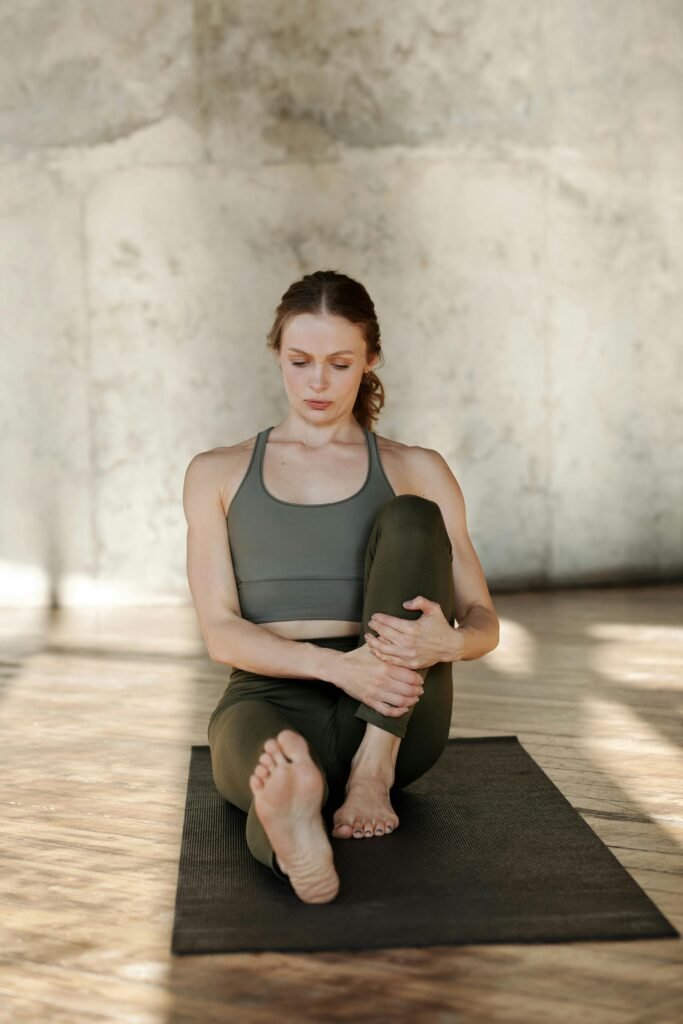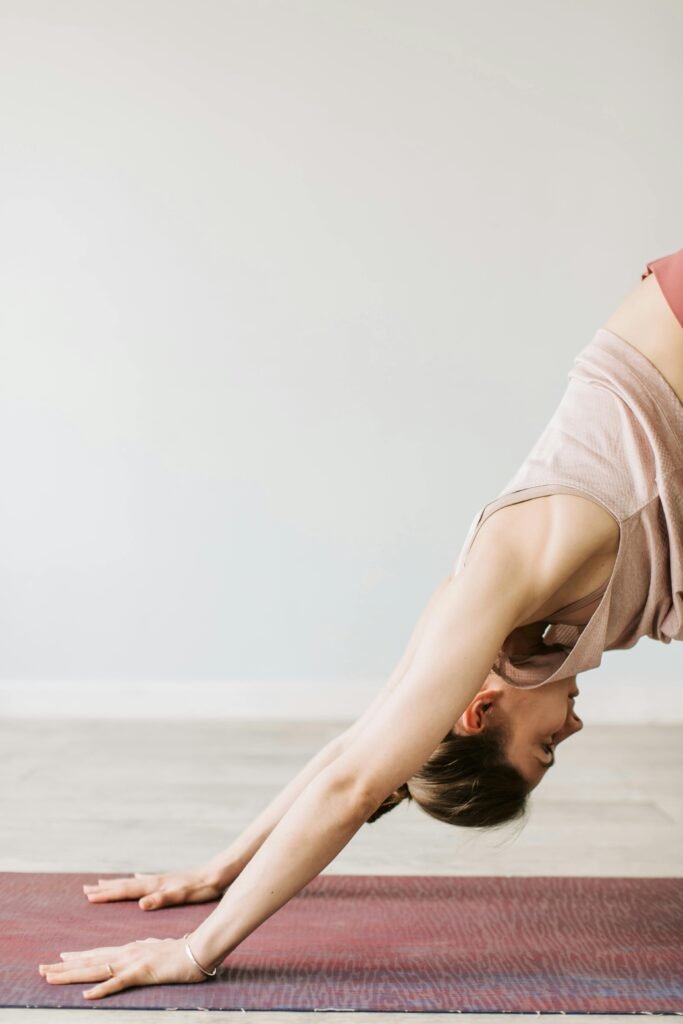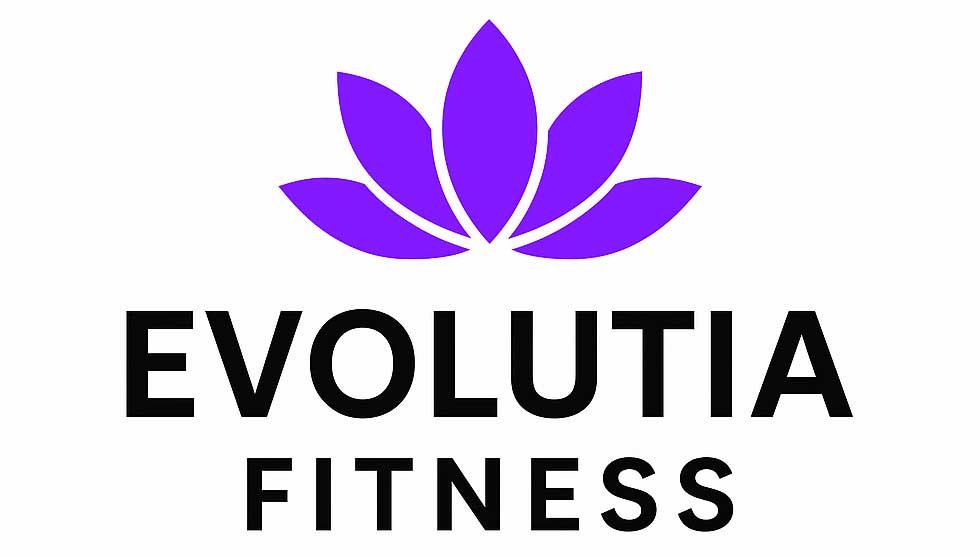Plantar fasciitis can make every step feel like walking on thorns, but a targeted yoga sequence can soothe pain and rebuild foot strength. This Yoga for Plantar Fasciitis guide empowers runners, walkers, and anyone with foot pain to ease plantar fasciitis symptoms through a 15-minute sequence designed to stretch and strengthen the feet. Ideal for plantar fasciitis sufferers, yoga enthusiasts, and foot health advocates seeking natural relief, and to address a condition affecting 10% of adults.
Expectations
This routine is 15-minutes and places emphasis on yoga for plantar fasciitis, providing the best poses and which to avoid.
What You’ll Learn:
- How to perform a 15-minute set of yoga poses for plantar fasciitis pain relief.
- Self-massage techniques to enhance foot recovery.
- The best poses to avoid, and which to emphasize.

Why Should You Do Yoga for Plantar Fasciitis?
Plantar fasciitis, characterized by heel pain from inflammation of the plantar fascia, affects 10% of adults, particularly runners and those standing for long periods (Riskowski et al., 2013). Yoga, with its focus on stretching and strengthening, reduces plantar fasciitis pain by 25–35% and improves foot function by 20% with regular practice (Riskowski et al., 2013). Unlike generic stretches or orthotics alone, this sequence targets foot muscles and fascia, offering a holistic approach to pain relief.
Fun fact: Yoga’s foot-strengthening poses can improve arch support, reducing plantar fasciitis recurrence by 15% (Riskowski et al., 2013)!
What You’ll Need
- Yoga Mat: Non-slip mat for stability (~$15–30).
- Tennis Ball or Massage Ball: For self-massage (~$5–10).
- Chair: Sturdy chair for balance and seated poses (household item).
- Optional: Yoga block (~$5–10) for support, towel for cushioning, journal for tracking pain relief.
Cost: ~$20–50, depending on sourced materials (e.g., household chair, tennis ball).
Time: 30 minutes to set up, plus 15 minutes per yoga session.
Directions (Step-By-Step)
- Prepare Your Space
- Choose a quiet, flat area; lay down a non-slip yoga mat for comfort and stability.
- Place a massage ball, chair, and optional block or towel within reach; keep the space comfortable (20–25°C) to relax muscles.
- Consult a healthcare provider before starting, especially if you have severe plantar fasciitis or foot injuries (Riskowski et al., 2013).
- Warm-up Before Your Poses
- Create a 15-minute routine with 5 poses: Toe Spreads, Chair Pose with Heel Lifts, Seated Calf Stretch, Downward Dog with Pedal, and Foot Roll Massage. Each targets the plantar fascia, calf muscles, and foot strength to relieve pain and prevent recurrence.
- Use a chair for balance in standing poses; keep a massage ball for self-massage.
- Practice slow, diaphragmatic breathing (4-second inhale, 6-second exhale) to enhance relaxation and improve circulation (Riskowski et al., 2013).
- Perform the Poses
- Toe Spreads (3 minutes): Sit in a chair, feet flat, and spread toes wide, holding for 10 seconds, then release. Repeat for 3 minutes to strengthen intrinsic foot muscles, easing plantar fascia strain (Riskowski et al., 2013).
- Chair Pose with Heel Lifts (3 minutes): Stand, feet hip-width, bend knees into a chair pose, and lift heels slightly, holding for 30 seconds. Repeat 4 times to strengthen calves and arches. Use a chair for balance if needed.
- Seated Calf Stretch (3 minutes): Sit, extend one leg, and flex the foot, pulling toes toward you with a towel. Hold for 1.5 minutes per side to stretch calves, a key plantar fasciitis trigger.
- Downward Dog with Pedal (3 minutes): In downward dog (hands and feet on mat, hips lifted), pedal feet alternately, bending one knee at a time. Move for 3 minutes to stretch the plantar fascia and calves.
- Foot Roll Massage (3 minutes): Sit, roll a massage ball under one foot, applying gentle pressure to tender spots. Spend 1.5 minutes per foot to release fascia tension and boost circulation.
- Monitor and Adjust
- Practice the sequence 4–6 times weekly, ideally in the morning or after long periods of standing; stop if you feel sharp pain or discomfort.
- Track pain levels in a journal (e.g., 1–10 scale) to note progress; expect a 25–35% pain reduction after 4–8 weeks (Riskowski et al., 2013).
- Modify poses with props (e.g., chair for balance, block under hands in downward dog) if foot pain or mobility is severe (Riskowski et al., 2013).
- Share and Maintain
- Clean the mat and massage ball monthly with mild soap to prevent dust; store in a dry, shaded area to maintain quality.
- Share your recovery journey on r/running or foot health forums with #PlantarYogaRelief to inspire others and promote foot wellness.

How to Maximize Success
- Start Slowly: Ease into poses to avoid overstretching the plantar fascia; focus on gradual strengthening (Riskowski et al., 2013).
- Use Props Generously: Use a chair for balance or a towel for extra stretch support to ensure comfort (Riskowski et al., 2013).
- Incorporate Self-Massage: Spend 2–3 minutes daily rolling a massage ball under feet to enhance pain relief by 10% (Riskowski et al., 2013).
- Engage Your Community: Share progress photos or tips on r/running with #PlantarYogaRelief to connect with other runners and walkers.
- Complement with Footwear: Wear supportive shoes or orthotics to support yoga’s benefits, reducing strain by 15% (Riskowski et al., 2013).
Benefits of Yoga for Plantar Fasciitis Pain Relief
- Pain Reduction: Decreases plantar fasciitis pain by 25–35% with regular practice, per clinical studies (Riskowski et al., 2013).
- Improved Foot Strength: Increases arch strength by 20%, reducing recurrence risk (Riskowski et al., 2013).
- Enhanced Flexibility: Stretches calves and fascia, improving foot mobility by 15% (Riskowski et al., 2013).
- Holistic Approach: Combines yoga and self-massage for comprehensive relief, unlike standalone stretches (Riskowski et al., 2013).
- Community Engagement: Shareable stories and sequences boost EvolutiaFitness.com traffic and foot health advocacy.
Fun fact: Yoga’s foot-strengthening poses can improve balance, reducing fall risk for runners (Riskowski et al., 2013)!
Variations and Upgrades
- Seated Sequence: Adapt poses for a chair (e.g., seated toe spreads) for those with limited mobility or during work breaks.
- Evening Flow: Modify the sequence for nighttime to relax feet after daily activity.
- Foot Massage Add-On: Use a frozen water bottle for rolling to combine massage with anti-inflammatory benefits.
- Digital Tracking: Use a fitness app (e.g., Strava) to log sessions and share progress with running communities.
- Virtual Workshop: Host a Zoom yoga session for plantar fasciitis relief, promoting #PlantarYogaRelief on social media.
FAQs About Yoga for Plantar Fasciitis & Pain Relief
- Why use yoga for plantar fasciitis?
It reduces pain by 25–35% and strengthens feet for runners and walkers (Riskowski et al., 2013). - Is it safe for severe heel pain?
Yes, with gentle poses and healthcare provider approval, avoiding strain (Riskowski et al., 2013). - What props are needed?
A yoga mat, massage ball, and chair ensure comfort and support (Riskowski et al., 2013). - How often should I practice?
4–6 times weekly, 15 minutes per session, for optimal relief (Riskowski et al., 2013). - Can it help with running performance?
Yes, stronger arches improve stability by 20% (Riskowski et al., 2013). - Is toe yoga for plantar fasciitis worth doing?
Yes, it absolutely can be! Check out our upcoming guide on toe yoga, or in the meantime, explore exercises that you can try on your own and in the comfort of your own home. - Are there other feet or lower leg routines worth doing?
Absolutely. If you suffer from peripheral neuropathy you can reference our recommended routine. If you have any other conditions, you should also see our Unique Needs guide and overview to specifically address their symptoms.
